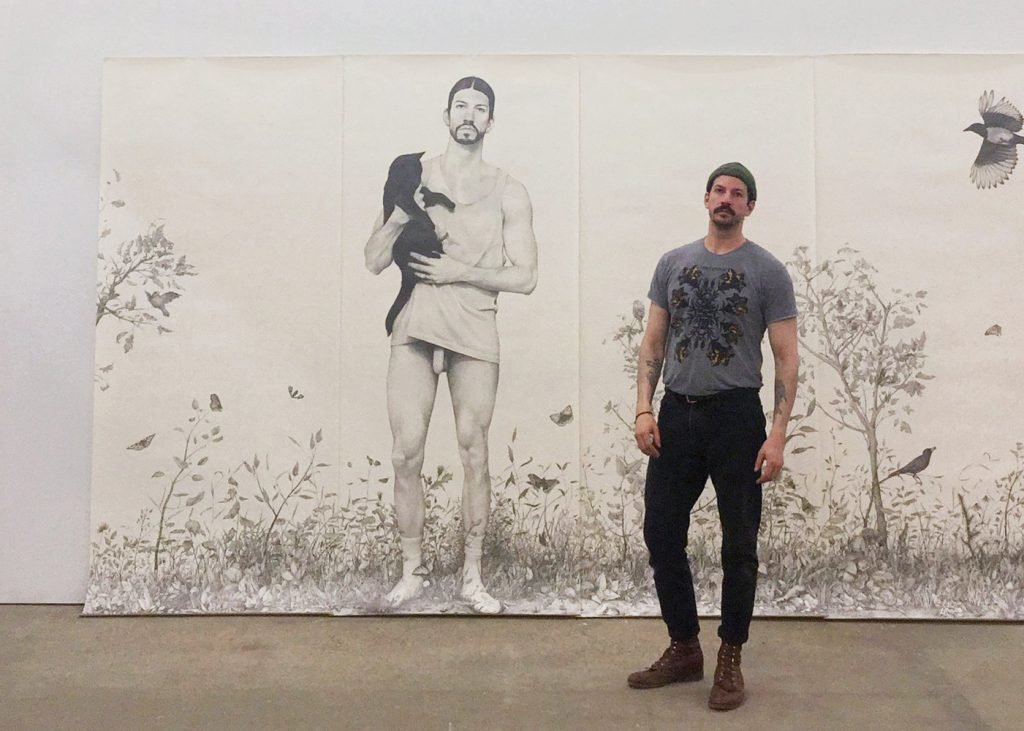
Zachari Logan: ‘the body, the self’
May 24, 2018
Zachari Logan utilizes painting, drawing and ceramics to investigate subjectivities and bodies in conjured spaces. Often containing slightly larger than life self-portraits, Logan’s work explores identity, masculinity, queerness, and memory. The survey exhibition Naked Animals: Selected Bodies, is a collection of delicate drawings and paintings that trace Logan’s examination of the figure – both formally and conceptually – as it intertwines with art historical and contemporary narratives of ‘the body, the self’.
Naked Animals: Selected Bodies 2008-2018, Zachari Logan’s first solo exhibition at dc3 Art Projects, is open to the public May 4th – June 16th, 2018. Shortly after the exhibit opened, Jessa Gillespie from dc3 Art Projects discussed with him the formal language present within his work, and the impact that this language has had on depictions of identity and narrative. Together they trace the evolution of his practice over the last ten years, and how it came to manifest in the work presented in Naked Animals: Selected Bodies.
< jessa gillespie > I want to begin by chatting a bit about your relationship to process. With these painstakingly rendered drawings and paintings taking the form of hyper-realistic images, I’m curious about this mode of commitment and your personal relationship to labour & this form of image making.
< zachari logan > My relationship to labour is linked to my narratives and conceptual concerns surrounding the body, the self. Drawing is an incredibly direct mode in which to create images; an extension of the body, drawing is labour, drawing is thinking. I primarily moved to drawing because the mode in which I painted was to retain the stylistic references to history I wished to articulate, but it was less immediate, and created an intellectual distance that the immediacy of drawing never has. This is due to the fact that the painting process I employed was laborious with incredibly time-consuming stages: first is drafting/drawing, then painting a grisaille or grey underpainting, and finally many successive layers of colour. So after getting a third of the way finished a given painting, there at times was a struggle to retain utter engagement the way I can with drawing, which is still very labour intensive, but more immediate. However, I did recently revisit painting when I was artist in residence in the Tom Thomson Shack in the site of the McMichael Canadian Art Collection, due in part to the fact that I was commissioned to commemorate the centenary of Thomson’s death and I wanted to reference his materials and the legacy his practice as a painter has had on Canada, so I painted a 7 x 7 ft. composition as a sort of cenotaph. I also use ceramics as an extension of my drawing practice; I create objects from clay in a similar direct way, with the hand, through a combination of observation and construction. The reference to the body is always explicit, no matter the imagery.
< jessa > The visual language of your work takes note from the tradition of Renaissance & Baroque portraiture. What is your relationship to this visual language and how does this history effect your decision-making when creating work?
< zachari > Although I rarely paint anymore, my drawings in all media reference the history of art, and to a large degree the language of narrative, figurative painting. Initially, it was an analytical exercise in deciphering the codification of the male body as a locus for sexuality and violence. The painting Beautiful Losers is a prime example of this type of investigation. I was certainly influenced from a young age being raised Catholic, and thus being exposed to images of the body, primarily the male nude in the form of Christ or saint figures. However, be they secular or religious, historical imagery involving the body is deeply political and effectual to contemporary constructions of gender and sexuality. In continually drawing my body as a site of orientation with stylistic references to Baroque and Renaissance imagery, I reveal a performance that is anxious, and often undercuts accepted ideas of the male body. The earlier figurative works are multi-layered in the sense that they are articulating something about me, but they are equally about the person in front of the work. The body is often posed frontal, perhaps sensually – but also confrontational and somewhat absurdly. My body, being the one that is depicted, and the body that physically created these images, complicates the viewing experience. I am clearly in control of what the viewer sees, but not what the viewer feels about what they see.
< jessa > The importance of this visual language & history appears explicitly in your series, Helping Hands. Can you speak a bit about these intimate moments you studied within the Louvre, specifically about the content that you chose to be attentive to?
< zachari > This series of drawings from 2009 are the result of an extended residency in Paris. I travelled to Paris for the opening of my first exhibition there in January of 2009 at Galerie Jean Roch Dard. This exhibition was merely months after finishing my master’s degree, where during my studies, I had been influenced by many of the paintings in Paris museums, primarily the Louvre. I had a profoundly moving experience in viewing these works, partially due to the sheer scale of them, the physical effect they had on my body, and their extreme beauty as objects. I realized how strange it was that I had been studying and referencing these paintings in print alone. I decided soon after that I needed to return for an extended period of time to truly absorb them. So I devised, with the help of the Saskatchewan Arts Board, a self-directed residency and returned to Paris that summer to carry out a 3-month study of the neo-classical masterpieces in the grand hall. I spent almost every day of my time there examining several key works by David, Gericault, Gros and Delacroix. These works, usually glorifying the spoils of war, all contained the bodies of men in various states of injury, death and/or decay; but the bodies of the men depicted are sensually situated among or rather entwined with other beautiful men. There are incredibly honest moments of male-male intimacy depicted that I decided to zero-in on, in order to elevate them to a level of visual importance I felt would spotlight their compositional and narrative inclusion. I suppose I was asking why they were there, and celebrating their presence. These drawings, in part, ended up being the subject I based Beautiful Losers on in the building up of space and gesture. Subtle references to the smaller drawings echoed in the larger figures evolved a language that hovered in the painting between absurdity and the mundane.
< jessa > In all of the work present within this exhibition, there is a morphing relationship to site & context. I wonder if you could unpack why these works are situated in imagined spaces & worlds.
Vignette, 2011, graphite on paper, 110 x 200 inches.
< zachari > Everything I depict is, in a way, fictive in its outcome- but fabricated through experience. For example, Vignette is a drawing that combines species of both flora and fauna from Tennessee, (where I began the drawing) and from Saskatchewan (where it was completed) in my Saskatoon studio. This drawing was composed through photographs I took of plant and animal life I encountered in both places, and positioned together to imagine a naturalistic space that was prelapsarian, including both my body, that of my husband Ned and our two cats, Willow and Asherah. This drawing was created for a show called Domestic Queens, at Concordia’s FOFA Gallery; the theme of which was men in domestic relationships with other men. I wanted to depict a family portrait that confronted the inane religious conversation of natural vs. unnatural in relation to queer relationships in the broader context of a heterosexist society.
< jessa > How does this play into narratives within the work?
< zachari > This plays into all of my work even the ones with the simplest of spaces, where bodies are defined solely in space by cast shadows; in that they point metaphorically to the spaces in which queer bodies exist, within a society such as ours. A narrow or liminal space defined by a will to flourish; somewhat like the weeds I populate the bottom edges of my Eunuch Tapestry drawings with.
Enigma 1, 2016, from Green Man series
Blue pencil on mylar, 8 x 9.25 inches
< jessa > You’ve spoken about this concept of ‘re-wilding’ as being a tactic for exploring identity in relation to the natural environment. Can you speak to this term and the amalgamation of human/flora/fauna in your Green Man series?
< zachari > The Wild Man, Green Man and Leshy series as well as the drawing Emperor’s New Clothes are all from a larger grouping of drawings I like to call the Natural Drag series, drag in the sense that I am portraying myself as a fantastical character, an embodiment of natural process – participating in the spectacle of nature. Essentially, these are elusive characters; historical constructs I find very interesting in part because of their locality in the psyche. They personify landscape, and for me are queerly centered as outsiders. I would say that adornment can be celebratory, showing-off can be about announcing one’s self, professing freedom and equanimity – as interestingly, adornment is also equally about confinement. Embellishment obscures as much as it enhances, take make-up for example, usually one cover’s-up before they enhance or embellish their features, or the act of covering-up is thought of as enhancing. One possibly becomes more visible, but visible in an altered manner. In this way, queerness “engulfs” me, with visual cues from natural phenomenon, such as at the Mariposa, where monarch butterflies cover so much of a tree’s branches that they cause its branches to tear off (as I reference in the drawing Emperor’s New Clothes). Extending the self-portrait to the dramatic is a strategy I revisit often.
< jessa > Beautiful Losers feels different in relation to the other work in this show. The many you’s are engaging with objects and the space in curious and occasionally unsettling ways. Can you speak to your relationship with the content of the painting, and the decision to have so many self-portraits occupying the same space?
Beautiful Losers, 2010, oil on canvas, 118 x 210 in
< zachari > I am fascinated with the idea of multiple selves, a theme I have revisited in several ways throughout the past 10 years. In the Duality series of which Duality 1, Adam & Eve (also in Naked Animals), is a drawing from; I depict several historical characters through a single pose, usually characters whose depictions have historically had a profound impact on how society interprets gender and sexuality.
I began thinking about the doppelgänger or several selves as an extension of ego, as a way to address narcissism, and its complications. In Beautiful Losers, the largest work to include multiple figures, I was working to create a space that incorporated multiple selves with the physicality of a neo-classical work. My desire was to make a work that was physically demanding, leaving the viewer wondering, curious about the intention implied by scale of the work; the relation of the scale of the work to the viewer’s body. The physical intimacy of male bodies and consequent absurdity in neoclassical masterpieces interested me in relation to the meaning communicated by these works to their initial viewers, and the loss of this communicated intimacy and absurdity through time and shifting cultural context.
Just as virtual platforms of self-documentation were emerging; when the Selfie was about to erupt (2009), I was constructing an artefact for viewers to interpret: imagine a digital feed filled with endlessly mundane self-portraits of eating, working and taking out the garbage.



